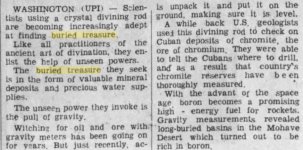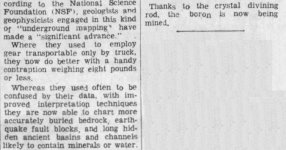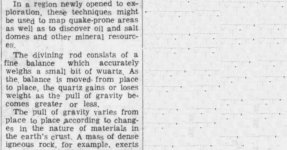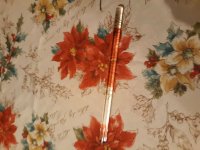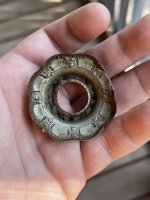You are using an out of date browser. It may not display this or other websites correctly.
You should upgrade or use an alternative browser.
You should upgrade or use an alternative browser.
Crystal Divining Rod Finding Buried Treasure
- Thread starter jeff of pa
- Start date
Carl-NC
Bronze Member
- Mar 19, 2003
- 1,871
- 1,359
- Detector(s) used
- Custom Designs and Prototypes
- Primary Interest:
- All Treasure Hunting
It's an unfortunate choice of words. What the article is talking about is an early gravimeter, probably with a quartz spring. RealScience, not WishScience, regardless of the misleading description.
dowser
Hero Member
- Jul 13, 2005
- 904
- 335
- Detector(s) used
- MINELAB 2100, L-Rods
- Primary Interest:
- All Treasure Hunting
signal_line
Silver Member
- Nov 14, 2011
- 3,601
- 1,835
- Detector(s) used
- XP Deus
- Primary Interest:
- All Treasure Hunting
Some of those toaster ovens have quartz rods. Never tried one.
As for gravity detector, some people would hold a crowbar over their head and walk until they felt the extra weight when over a water source.
"Y"-rods they say will pull down or lift up over a target. I wonder if this is gravity related. Don't discount that a human might be able to detect this slight difference.
As for gravity detector, some people would hold a crowbar over their head and walk until they felt the extra weight when over a water source.
"Y"-rods they say will pull down or lift up over a target. I wonder if this is gravity related. Don't discount that a human might be able to detect this slight difference.
- Thread starter
- #5
Some of those toaster ovens have quartz rods. Never tried one.
As for gravity detector, some people would hold a crowbar over their head and walk until they felt the extra weight when over a water source.
"Y"-rods they say will pull down or lift up over a target. I wonder if this is gravity related. Don't discount that a human might be able to detect this slight difference.
I Once read there are Gravitational Differences where Water & Certain Ores Exists.
I Believe that is the reason Dowsing Works for those who Know how to Walk
without Subconsciously Interfering with the Rods/Sticks.
So that the Minor Changes can be Noticed.
Which at least to Me, Explains why Dowsing Does work.
Beats believing there are dowsing Spooks, who Haunt Forked Sticks & Dowsing Rods. Just to make them Point at water or Gold.
until recently I thought the Pull was Down.
Recently I read of a Dowser saying the stick Rises ? this Contradicts the
Gravity excuse though. as Gravity Can't Push, Just weaken .
or Pull. I Think

Last edited:
signal_line
Silver Member
- Nov 14, 2011
- 3,601
- 1,835
- Detector(s) used
- XP Deus
- Primary Interest:
- All Treasure Hunting
Yeah, it depends on the target polarity.
Red_desert
Gold Member
- Feb 21, 2008
- 6,850
- 3,500
- Detector(s) used
- Garrett Ace 250/GTA 1,000; Fisher Gold Bug-2; Gemini-3; Unique Design L-Rods
- Primary Interest:
- All Treasure Hunting
Scientist now believe gravity is just another type of wave, which can be converted to an audio sound. They have been waiting to catch gravity waves from space and I read about one experiment was supposedly successful. Read a few years ago, of a pvc tube detector scientist were building, the length would not fit on your property. Apparently, scientist picked up a gravity wave event, something happened in the universe many years back. Some scientist hope to eventually develop a type of imaging from gravity waves.
Last edited:
Red_desert
Gold Member
- Feb 21, 2008
- 6,850
- 3,500
- Detector(s) used
- Garrett Ace 250/GTA 1,000; Fisher Gold Bug-2; Gemini-3; Unique Design L-Rods
- Primary Interest:
- All Treasure Hunting
https://www.theguardian.com/science...scovery-hailed-as-breakthrough-of-the-century
[FONT=Verdana,Arial,Tahoma,Calibri,Geneva,sans-serif]Physicists have announced the discovery of gravitational waves, ripples in the fabric of spacetime that were first anticipated by Albert Einstein a century ago.
“We have detected gravitational waves. We did it,” said David Reitze, executive director of the Laser Interferometer Gravitational-Wave Observatory (Ligo), at a press conference in Washington.
The announcement is the climax of a century of speculation, 50 years of trial and error, and 25 years perfecting a set of instruments so sensitive they could identify a distortion in spacetime a thousandth the diameter of one atomic nucleus across a 4km strip of laserbeam and mirror.
The phenomenon detected was the collision of two black holes. Using the world’s most sophisticated detector, the scientists listened for 20 thousandths of a second as the two giant black holes, one 35 times the mass of the sun, the other slightly smaller, circled around each other.
At the beginning of the signal, their calculations told them how stars perish: the two objects had begun by circling each other 30 times a second. By the end of the 20 millisecond snatch of data, the two had accelerated to 250 times a second before the final collision and a dark, violent merger.[/FONT]
[FONT=Verdana,Arial,Tahoma,Calibri,Geneva,sans-serif]Physicists have announced the discovery of gravitational waves, ripples in the fabric of spacetime that were first anticipated by Albert Einstein a century ago.
“We have detected gravitational waves. We did it,” said David Reitze, executive director of the Laser Interferometer Gravitational-Wave Observatory (Ligo), at a press conference in Washington.
The announcement is the climax of a century of speculation, 50 years of trial and error, and 25 years perfecting a set of instruments so sensitive they could identify a distortion in spacetime a thousandth the diameter of one atomic nucleus across a 4km strip of laserbeam and mirror.
The phenomenon detected was the collision of two black holes. Using the world’s most sophisticated detector, the scientists listened for 20 thousandths of a second as the two giant black holes, one 35 times the mass of the sun, the other slightly smaller, circled around each other.
At the beginning of the signal, their calculations told them how stars perish: the two objects had begun by circling each other 30 times a second. By the end of the 20 millisecond snatch of data, the two had accelerated to 250 times a second before the final collision and a dark, violent merger.[/FONT]
Last edited:
Red_desert
Gold Member
- Feb 21, 2008
- 6,850
- 3,500
- Detector(s) used
- Garrett Ace 250/GTA 1,000; Fisher Gold Bug-2; Gemini-3; Unique Design L-Rods
- Primary Interest:
- All Treasure Hunting
I think it has been about 10-12 years, but the crystal balance dowsing rods were very popular and made by people in the UK. I tried to find a photo of one, doesn't seem to be any on the Internet right now. I made this realistic photo in Paint Shop Pro, it is exactly what these rods looked like. The handle is at a balanced point between the crystal ends in a copper tube which is same diameter as the handle. Back end crystal is shorter and front crystal longer. I'm not sure if they came as a pair or a single rod.
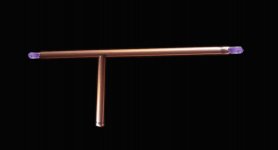

Red_desert
Gold Member
- Feb 21, 2008
- 6,850
- 3,500
- Detector(s) used
- Garrett Ace 250/GTA 1,000; Fisher Gold Bug-2; Gemini-3; Unique Design L-Rods
- Primary Interest:
- All Treasure Hunting
I think you're right, I read somewhere it started with 3 springs. The quartz followed, here is an article.It's an unfortunate choice of words. What the article is talking about is an early gravimeter, probably with a quartz spring. RealScience, not WishScience, regardless of the misleading description.
https://www.ncsli.org/mo/bid/mo/Articles/bid2010.aspx?hkey=d4f656e5-475a-438e-93d0-834c4c65c02d
[FONT=Verdana,Arial,Tahoma,Calibri,Geneva,sans-serif]One of the most unique and sophisticated pressure sensors is the fused quartz bourdon tube or capsule. The fused quartz bourdon tube should not be confused with the quartz resonator pressure sensors, which use quartz crystals and are currently designed and marketed by companies such as Paroscientific and Quartzdyne. Fused quartz tubing is manufactured by melting naturally occurring high purity quartz crystals at approximately 2000 °C and then extruding the melted quartz into various diameters and wall thicknesses. This type of tubing is transparent and looks almost like glass.[/FONT]
[FONT=Verdana,Arial,Tahoma,Calibri,Geneva,sans-serif]Some of the early development of the quartz bourdon can be traced back to Sam Worden, who was most noted for his pioneering work in gravimeters. The Worden Gravity Meter has the capability of measuring relative gravity to 1 part in 100,000,000 or a difference in elevation of only1 inch. Before Sam Worden started fabricating quartz bourdon tubes at Worden Labs for Ruska Instruments (early 1960s), he built some low resolution models for use in scientific labs. Walter Ruska, the founder of Ruska Instruments, left Ruska before any developmental or engineering efforts were started at Ruska on quartz measuring instruments.[/FONT]
[FONT=Verdana,Arial,Tahoma,Calibri,Geneva,sans-serif]Why fused quartz? Many would ask why fused quartz was chosen to be a pressure sensing element. Dating back to the use of fused quartz in gravimeters, it was well known that it made an almost perfect spring material. Since fused quartz had a very low coefficient of thermal expansion, low thermoelastic modulus and low internal viscosity the “stage was set” to use fused quartz as the breakthrough bourdon material. The metallic bourdons – such as beryllium copper, phosphor bronze, 316 stainless steel, NiSpan C, etc. – could not compare in terms of hysteresis, resolution and repeatability. Early work by K.R. Bodenstein, J.B. “Pete” Damrel and others indicated that it was possible to fabricate a bourdon tube from fused quartz.[/FONT]
Last edited:
Metaldetectors-ar
Newbie
- Aug 11, 2020
- 2
- 2
- Detector(s) used
- Dowsing rods
- Primary Interest:
- All Treasure Hunting
Thank you
Top Member Reactions
-
 2329
2329 -
 1125
1125 -
 1049
1049 -
 892
892 -
 832
832 -
 777
777 -
 745
745 -
 745
745 -
 607
607 -
 502
502 -
 489
489 -
 475
475 -
 460
460 -
 419
419 -
 397
397 -
 393
393 -
O
393
-
 382
382 -
 381
381 -
 379
379
Users who are viewing this thread
Total: 2 (members: 0, guests: 2)
Latest Discussions
-
-
Experts only, please help if you can decode the engraved drawing
- Latest: Treasure_Hunter
-
-



